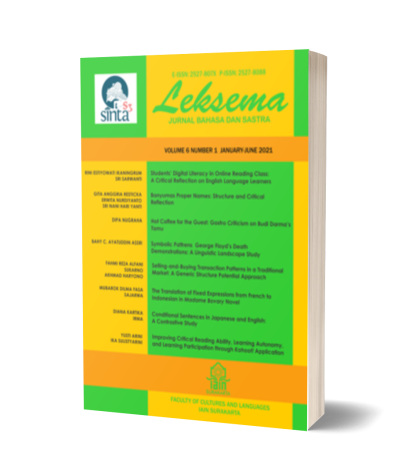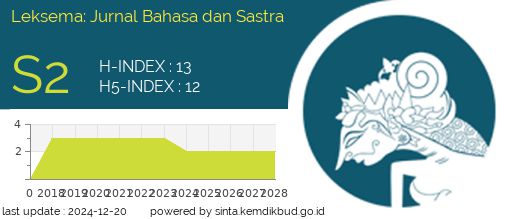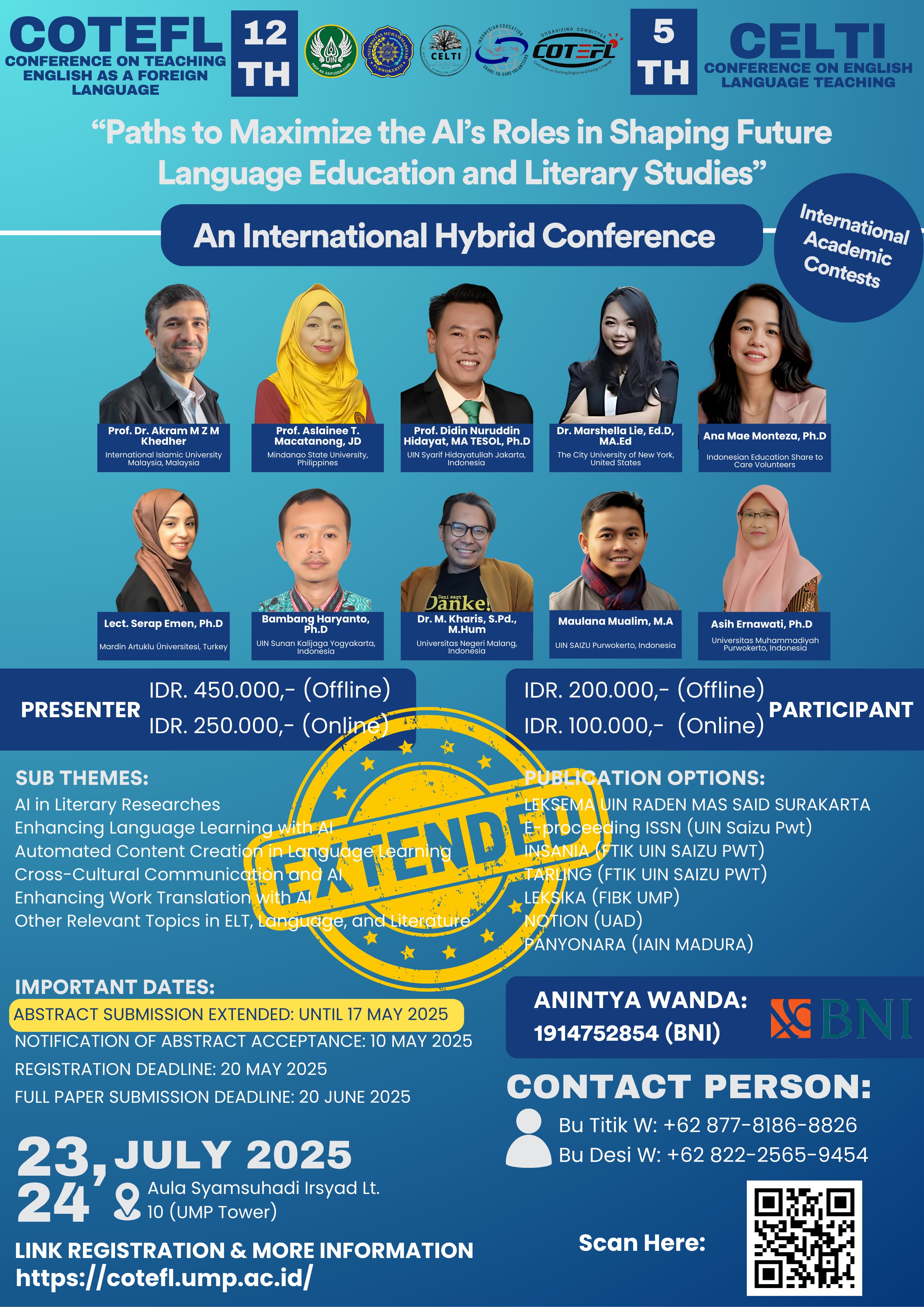PREPOSITIONAL INCORPORATION IN TOBA BATAKNESE LANGUAGE
DOI:
https://doi.org/10.22515/ljbs.v10i1.11386Keywords:
incorporation, preposition, Toba BatakneseAbstract
The purpose of this study is to describe the process of combining prepositions, the rules of combining prepositions, and the forms of prepositions in the Toba Bataknese language. This study used a descriptive-qualitative method whose data are in the forms of texts. The techniques for data analysis include removal, replacement, insertion of reversals, and changes occurrence. The results; of this study; indicate that; the combination of prepositions in Toba Bataknese language can be seen from the movement of prepositions in verbs. The emergence of the suffixes -i and -hon in verbs has changed the argument structure of intransitive verbs into transitive verbs. Likewise, transitive verbs change into ditransitive verbs. The changes in the structure of the verb arguments consist of (1) Subj - V (intr) - Obl à Subj - V (tr) - Obj; (2) Subj - V (tr) - Obj - Obl à Subj - V (dtr) - Obj - Cho. The prepositional forms combined with Toba Bataknese verbs can be divided into two types, namely (1) prepositional forms that change into the suffix -i and (2) prepositional forms that change into the suffix -hon. The prepositional forms that change into the suffix -i in the birth structure are di (in) and tu (to), while the prepositional forms that change into the suffix -hon are tu (to/for) and sian (from).
Downloads
References
Abbas, Asriani. 2014. Perilaku Morfosintaksis Verba Bahasa Makassar. Makassar: Program Pascasarjana Universitas Hasanuddin.
Abdullah, Ainun, Dakia N Djou, and Sitti Rachmi Masie. 2020. "Afiks Infleksi dan Derivasi dalam Bahasa Gorontalo". Jurnal Ideas: Pendidikan, Sosial, dan Budaya 6 (4): 397–414.
Ambarita, Esron, Himpun Panggabean, and Dona Enjel Loina Pasaribu. 2025. "Excessive Adjectives Using the Multiple Affixations ma-hu in Toba Batak. Journal of Applied Linguistics (JoAL) 4 (2), 109–122. DOI: 10.52622/joal.v4i2.334.
Arkadiev, Peter. 2019. "Morphology In Typology: Historical Retrospect, State of the Art, and Prospects". In Rochelle Lieber et al. (eds) The Oxford Encyclopedia of Morphology. DOI:10.1093/acrefore/9780199384655.013.626.
Baker, Mark C. 1985. Incorporation: A Theory of Grammatical Function Changing (PhD Disssertation. MIT
Blake, Barry J and Graham Mallinson. 1987. Language Typology and Syntactic Description. Amsterdam: North-Holland..
Dayal, Veneeta. 2015. "Incorporation: Morpho-Syntactic vs. Semantic Considerations". Syntax and Semantics 40: 47–87. DOI: 10.1163/9789004291089_003.
Dermawansyah, Muhammad. 2022. Perilaku Morfosintaksis Verba dalam Bahasa Kulisusu (Thesis). Makassar: Universitas Hasanuddin.
Fabrori, Fahri Muhaimin. 2023. "Teori Generatif Transformatif Noam Chomsky: Analisis Dalam Hadis Nabi Tentang Niat". Al-Bayan: Journal of Hadith Studies 2 (1): 1–11.
Faizah AR, Hasnah. 2008. "Inkorporasi Bahasa Melayu Riau Dialek Kampar". Jurnal Bahas 1(1): 16–26.
Farkas, Donka F and Henriette de Swart. 2003. The Semantics of Incorporation: From Argument Structure to Discourse Transparency. Center for the Study of Language and Information.
Greenberg, Joseph H. 1960. "A Quantitative Approach To the Morphological Typology of Language". International Journal of American Linguistics 26 (3): 178–194.
Haegeman, Liliane. 1994. Introduction to Government and Binding Theory. Hoboken: Wiley-Blackwell.
Hakim, Mohammad Andi. 2019. "Membanding Teori Transformasi Generatif dan Systemic Functional Grammar: Telaah Kritis-Dialogis Antar Madzab Linguistik". IJAS: Indonesian Journal of Arabic Studies 1 (1): 64-75. DOI: 10.24235/ijas.v1i1.4872.
Harahap, Evi Marlina. 2022. "Tipologi Sintaksis dalam Bahasa Batak Mandailing". Jurnal Hata Poda 1 (1): 14–21.
Irawati. 2023. Adjektiva Bahasa Melayu Dialek Sambas Kecamatan Sebawi Kabupaten Sambas. Pontianak: IKIP PGRI Pontianak.
Iswara, Agus Ari. 2017. "Fungsi Sintaksis dan Peran Semantik Argumen Frasa Verba Bahasa Bali". Retorika: Jurnal Ilmu Bahasa 1 (2): 388. DOI: 10.22225/jr.1.2.43.388-402.
Jehane, Hendrikus. 1996. "Inkorporasi dengan Pelesapan Verba dalam Bahasa Indonesia". Linguistika (Edisi Keempat) Maret: 61–69.
Kasman. 2021. "Peran Semantik Predikat Pada Verba Bervalensi Satu, Dua, Dan Tiga Dalam Bahasa Samawa Dialek Sumbawa Besar". Aksara 32 (2): 287–298. https://doi.org/ 10.29255/aksara.v32i2.445.287-298.
Katamba, Francis. 1993. Morphology. New York: Macmillan.
Katamba, Francis. 1993. "Morphological Mapping of Grammatical Functions". In Morphology: Modern Linguistics Series. London: Palgrave. DOI: 10.1007/978-1-349-22851-5_11.
Mahsun. 2017. Metode Penelitian Bahasa. Tahapan, Strategi, Metode, dan Tekniknya. Jakarta: Rajawali Press.
Markhamah, Atiqa Sabardila, and Dwi Haryanti. (2018). Teori Linguistik: Beberapa Aliran Linguistik. Muhammadiyah University Press.
Mithun, Marianne. 1984. "The Evolution of Noun Incorporation". Language 60 (4): 847–894. DOI: 10.2307/413800.
Mivtakh, Balkis Aminallah Nurul. 2023. "Teori Tata Bahasa Generatif Transformatif Chomsky serta Aplikasinya dalam Gramatikal Bahasa Arab". Allais: Journal of Arabic Language and Literature Studies 2 (1): 67–79. DOI: 10.22515/allais.v2i1.6460.
Mulyadi. 1997. "Inkorporasi Preposisi dalam Bahasa Indonesia". Linguistika (Edisi Keenam) March: 8–24.
Mulyono. 2013. Gejala Inkorporasi pada Bahasa Media Cetak. In Proceedings International Seminar: Language Maintenance and Shift III. 336–340. https://core.ac.uk/download/pdf/84727686.pdf
Nugroho, Mardi. 2017. "Pembentukan Kata dalam Bahasa Talondo". Sirok Bastra 5 (2): 123–130. DOI: 10.37671/sb.v5i2.102.
Parera, Jos Daniel. 2007. Morfologi Bahasa. Jakarta: Gramedia Pustaka Utama.
Sadler, Louisa and Andrew Spencer. 2017. "Morphology and Argument Structure". In Andrew Spencer and Arnold M Zwicky (eds.) The Handbook of Morphology: 206–236. Hoboken: John Wiley & Sons. DOI: 10.1002/9781405166348.ch10.
Samu, Albertina Yosefina. 2018. "Fungsi Sintaktis dan Peran Semantis Argumen Inti Bahasa Manggarai Dialek Manggarai Tengah". Linguistik Indonesia 36 (2): 186–204. DOI: 10.26499/li.v36i2.83.
Sawardi, FX, Sumarlam, and Dwi Purnanto. 2015. "Pergeseran Argumen dan Morfologi Verba Bahasa Jawa". Proceedings International Seminar Prasasti III: Current Research in Linguistics. 288–292. DOI: 10.20961/pras.v0i0.1514.
Isnainy, Sura and Mulyadi. 2019. "Verba Transitif dan Objek Dapat Lesap dalam Bahasa Karo". Lensa: Kajian Kebahasaan, Kesusastraan, dan Budaya 9 (1): 46–60. DOI: 10.26714/lensa.9.1.2019.46-60.
Setiyadi, Ag Bambang. 2006. Metode Penelitian untuk Pengajaran Bahasa Asing: Pendekatan Kuantitatif dan Kualitatif. Yogyakarta: Graha Ilmu.
Shopen, Timothy. 1985. Language Typology and Syntactic Description (Vol. 3). Cambridge: Cambridge University Press.
Simanjuntak, Faido and Mulyadi. 2019. "Incorporation with verb deletion in Toba Bataknese Language". International Journal of English Literature and Social Sciences 4(6): 1968–1971. DOI: 10.22161/ijels.46.53.
Simpen, I Wayan. 2015. "Dinamika Pembentukan Kata Bahasa Indonesia". Retorika: Jurnal Ilmu Bahasa 1(2): 319–330. DOI: 10.22225/jr.1.2.37.319-330.
Winaya, Made Detrichyeni and I Gusti Ngurah Adi Rajistha. 2017. "Proses Afiksasi Pada Inkorporasi Pelesapan Verba dalam Bahasa Bali". Kulturistik: Jurnal Bahasa Dan Budaya 1 (1): 1–11. DOI:10.22225/kulturistik.1.1.212.
Wiriani, Ni Made. 2016. "Relasi Gramatikal Oblik Dalam Klausa Bahasa Jepang". Jurnal Kotoba 3 (1): 1–14.
Zaim, M. 2014. Metode Penelitian Bahasa: Pendekatan Struktural. Padang: FBS UNP Press.
Zakariah, M Askari, Vivi Afriani and KH M Zakariah. 2020. Metodologi Penelitian Kualitatif, Kuantitatif, Action Research, Research and Development (R n D). Kolaka: Yayasan Pondok Pesantren Al Mawaddah Warrahmah.
Downloads
Published
Issue
Section
License
Copyright (c) 2025 Leksema: Jurnal Bahasa dan Sastra

This work is licensed under a Creative Commons Attribution-NonCommercial-ShareAlike 4.0 International License.
The copyright of the received article shall be assigned to the publisher of the journal. The intended copyright includes the right to publish the article in various forms (including reprints). The journal maintains the publishing rights to published articles.
In line with the license, the authors and users (readers or other researchers) are allowed to share and adapt the material only for non-commercial purposes. In addition, the material must be given appropriate credit, provided with a link to the license, and indicated if changes were made. If authors remix, transform or build upon the material, authors must distribute their contributions under the same license as the original.






